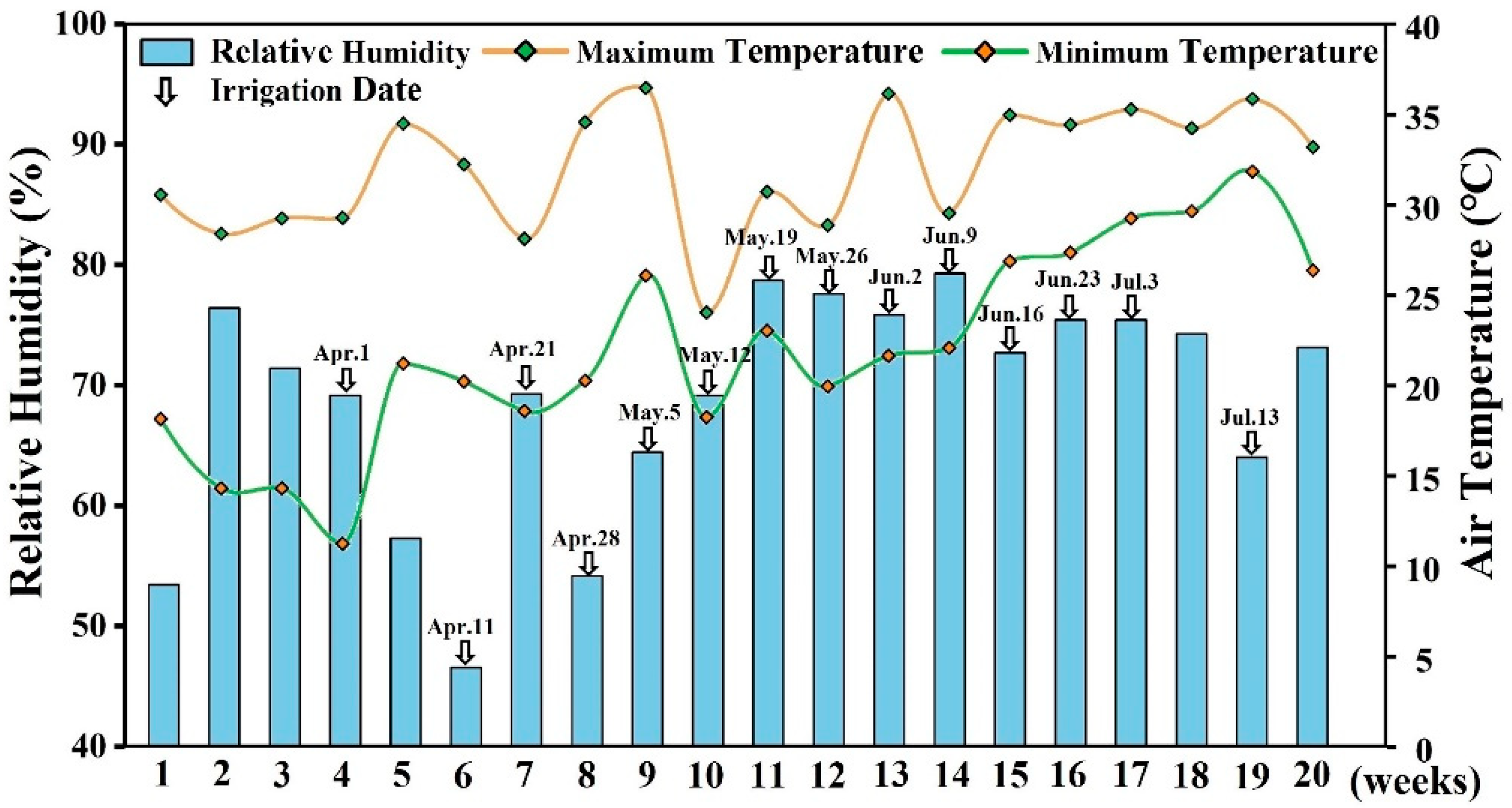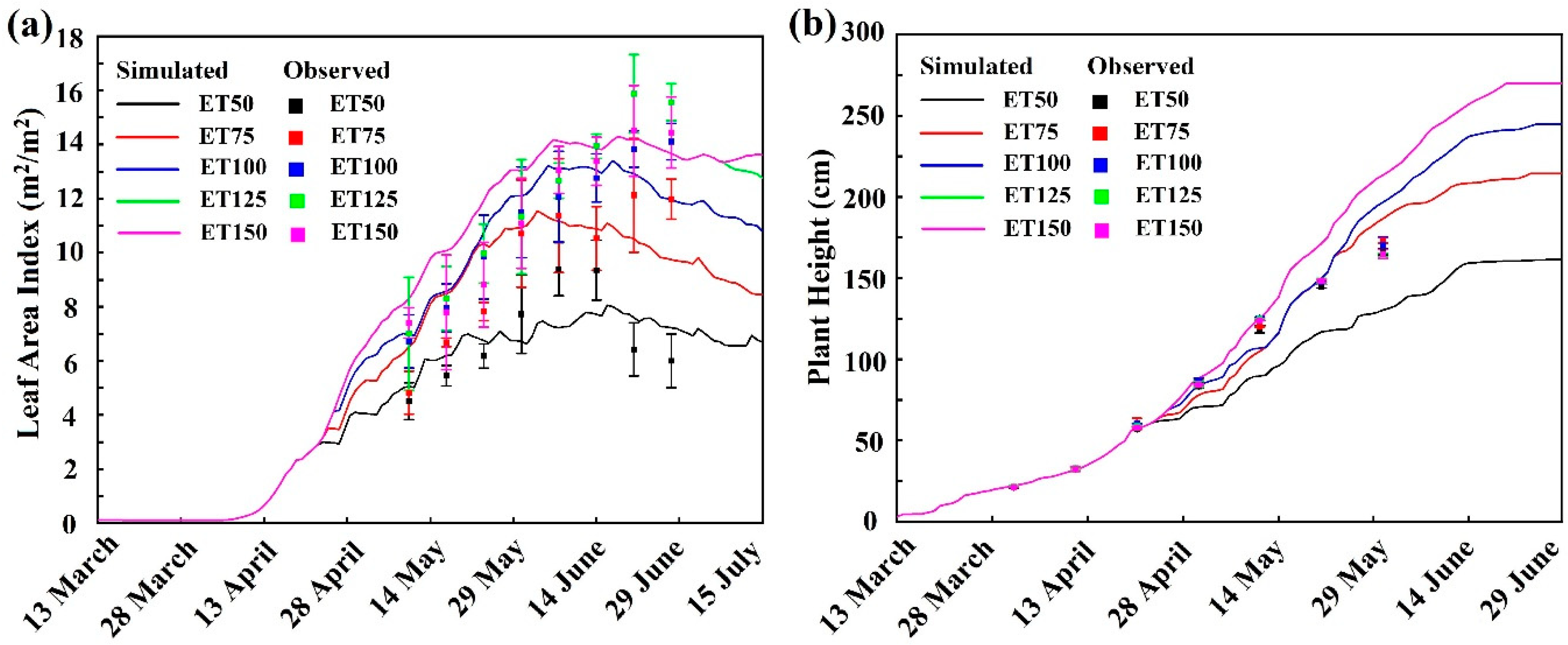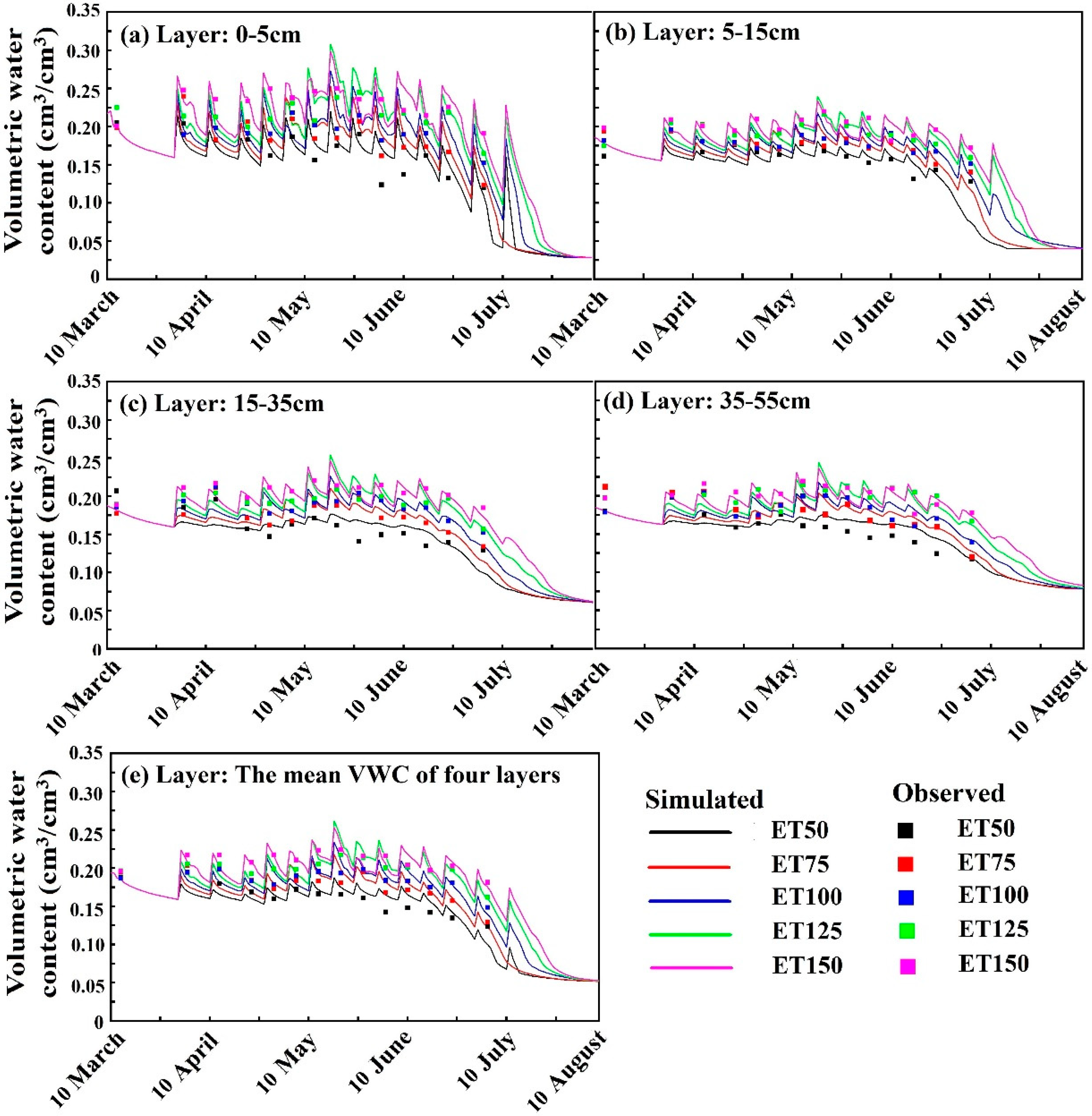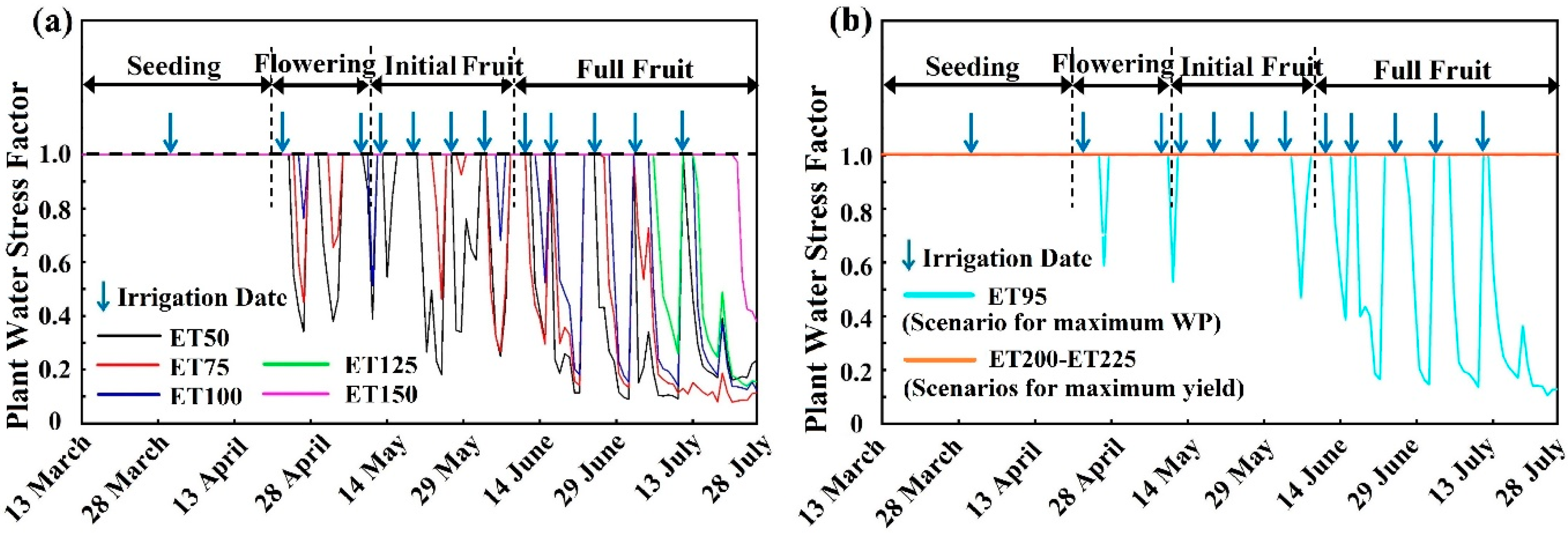Optimizing Deficit Irrigation Management to Improve Water Productivity of Greenhouse Tomato under Plastic Film Mulching Using the RZ-SHAW Model
Abstract
1. Introduction
2. Materials and Methods
2.1. Experimental Site and Plant Material
2.2. Field Management
2.3. RZ-SHAW Overview, Model Input and Calibration
2.3.1. Model Description
2.3.2. Model Input, Calibration and Validation
2.4. Statistical Analysis
2.5. Quantifying the Effects of Deficit Irrigation Levels using Calibrated RZ-SHAW
3. Results
3.1. Simulations of Tomato Growth Parameters
3.2. Simulations for Soil Water
4. Discussion
4.1. Simulated Plant Water Stress in Experimental Scenarios
4.2. Optimizing Deficit Irrigation Management for Maximizing Yield and Water Productivity
5. Conclusions
Supplementary Materials
Author Contributions
Funding
Institutional Review Board Statement
Informed Consent Statement
Data Availability Statement
Conflicts of Interest
References
- Barros, L.; Duenas, M.; Pinela, J.; Carvalho, A.M.; Buelga, C.S.; Ferreira, I.C.F.R. Characterization and quantification of phenolic compounds in four tomato (Lycopersicon esculentum L.) farmers’ varieties in northeastern portugal homegardens. Plant Food Hum. Nutr. 2012, 67, 229–234. [Google Scholar] [CrossRef] [PubMed]
- Food and Agriculture Organization. FAOSTAT. Area Harvested/Production/Yield Quantities of Tomatoes in World + (Total). Available online: https://www.fao.org/faostat/en/#data/QCL (accessed on 1 August 2022).
- Geng, G.; Wu, J.; Wang, Q.; Lei, T.; He, B.; Li, X.; Mo, X.; Luo, H.; Zhou, H.; Liu, D. Agricultural drought hazard analysis during 1980–2008: A global perspective. Int. J. Climatol. 2016, 36, 389–399. [Google Scholar] [CrossRef]
- Francesca, S.; Cirillo, V.; Raimondi, G.; Maggio, A.; Barone, A. A novel protein hydrolysate-based biostimulant improves tomato performances under drought stress. Plants 2021, 10, 783. [Google Scholar] [CrossRef] [PubMed]
- Antolinos, V.; Sanchez-Martinez, M.J.; Maestre-Valero, J.E.; Lopez-Gomez, A.; Martinez-Hernandez, G.B. Effects of irrigation with desalinated seawater and hydroponic system on tomato quality. Water 2020, 12, 518. [Google Scholar] [CrossRef]
- Khapte, P.S.; Kumar, P.; Burman, U.; Kumar, P. Deficit irrigation in tomato: Agronomical and physio-biochemical implications. Sci. Hortic. 2019, 248, 256–264. [Google Scholar] [CrossRef]
- Cheng, H.; Shu, K.; Zhu, T.; Wang, L.; Liu, X.; Cai, W.; Qi, Z.; Feng, S. Effects of alternate wetting and drying irrigation on yield, water and nitrogen use, and greenhouse gas emissions in rice paddy fields. J. Clean. Prod. 2022, 349, 131487. [Google Scholar] [CrossRef]
- Wang, D.; Zhang, H.; Gartung, J. Long-term productivity of early season peach trees under different irrigation methods and postharvest deficit irrigation. Agric. Water Manag. 2020, 230, 105940. [Google Scholar] [CrossRef]
- Cheng, M.; Wang, H.; Fan, J.; Fan, J.; Liao, Z.; Zhang, F.; Wang, Y. A global meta-analysis of yield and water use efficiency of crops, vegetables and fruits under full, deficit, alternate partial root-zone irrigation. Agric. Water Manag. 2021, 248, 106771. [Google Scholar] [CrossRef]
- Patanè, C.; Tringali, S.; Sortino, O. Effects of deficit irrigation on biomass, yield, water productivity and fruit quality of processing tomato under semi-arid mediterranean climate conditions. Sci. Hortic. 2011, 129, 590–596. [Google Scholar] [CrossRef]
- Mahmoud, M.M.A.; Fayad, A.M. The effect of deficit irrigation, partial root drying and mulching on tomato yield, and water and energy saving*. Irrig. Drain. 2022, 71, 295–309. [Google Scholar] [CrossRef]
- Wu, Y.; Yan, S.; Fan, J.; Zhang, F.; Zhao, W.; Zheng, J.; Guo, J.; Xiang, Y.; Wu, L. Combined effects of irrigation level and fertilization practice on yield, economic benefit and water-nitrogen use efficiency of drip-irrigated greenhouse tomato. Agric. Water Manag. 2022, 262, 107401. [Google Scholar] [CrossRef]
- Elnemr, M. Integration of subsurface irrigation and organic mulching with deficit irrigation to increase water use efficiency of drip irrigation. Inmateh-Agric. Eng. 2021, 64, 215–226. [Google Scholar]
- Jensen, C.R.; Battilani, A.; Plauborg, F.; Psarras, G.; Chartzoulakis, K.; Janowiak, F.; Stikic, R.; Jovanovic, Z.; Li, G.T.; Qi, X.B.; et al. Deficit irrigation based on drought tolerance and root signalling in potatoes and tomatoes. Agric. Water Manag. 2010, 98, 403–413. [Google Scholar] [CrossRef]
- Stoleru, V.; Inculet, S.C.; Mihalache, G.; Cojocaru, A.; Teliban, G.C.; Caruso, G. Yield and nutritional response of greenhouse grown tomato cultivars to sustainable fertilization and irrigation management. Plants 2020, 9, 1053. [Google Scholar] [CrossRef] [PubMed]
- Chand, J.B.; Hewa, G.; Hassanli, A.; Myers, B. Deficit irrigation on tomato production in a greenhouse environment: A review. J. Irrig. Drain. Eng. 2021, 147, 04020041. [Google Scholar] [CrossRef]
- Hemming, S.; de Zwart, F.; Elings, A.; Petropoulou, A.; Righini, I. Cherry tomato production in intelligent greenhouses-sensors and ai for control of climate, irrigation, crop yield, and quality. Sensors 2020, 20, 6430. [Google Scholar] [CrossRef]
- Huang, W.; Zhu, Y.L.; Wang, D.B.; Wu, N. Assessment on the coupling effects of drip irrigation and se-enriched organic fertilization in tomato based on improved entropy weight coefficient model. Bull. Environ. Contam. Toxicol. 2021, 106, 884–891. [Google Scholar] [CrossRef]
- Zhou, H.; Chen, J.; Wang, F.; Li, X.; Genard, M.; Kang, S. An integrated irrigation strategy for water-saving and quality-improving of cash crops: Theory and practice in China. Agric. Water Manag. 2020, 241, 106331. [Google Scholar] [CrossRef]
- Chen, N.; Li, X.; Shi, H.; Hu, Q.; Zhang, Y.; Hou, C.; Liu, Y. Modeling evapotranspiration and evaporation in corn/tomato intercropping ecosystem using a modified ERIN model considering plastic film mulching. Agric. Water Manag. 2022, 260, 107286. [Google Scholar] [CrossRef]
- Ouyang, Z.; Tian, J.C.; Zhao, C.; Yan, X.F. Coupling model and optimal combination scheme of water, fertilizer, dissolved oxygen and temperature in greenhouse tomato under drip irrigation. Int. J. Agric. Biol. Eng. 2021, 14, 37–46. [Google Scholar] [CrossRef]
- Dastranj, M.; Noshadi, M.; Sepaskhah, A.; Razzaghi, F.; Ragab, R. Soil salinity and tomato yield simulation using saltmed model in drip irrigation. J. Irrig. Drain. Eng. 2018, 144, 05017008. [Google Scholar] [CrossRef]
- Zhang, B.; Kang, S.Z.; Zhang, L.; Tong, L.; Du, T.S.; Li, F.S.; Zhang, J.H. An evapotranspiration model for sparsely vegetated canopies under partial root-zone irrigation. Agric. For. Meteorol. 2009, 149, 2007–2011. [Google Scholar] [CrossRef]
- Qi, Z.; Ma, L.; Bausch, W.C.; Trout, T.J.; Ahuja, L.R.; Flerchinger, G.N.; Fang, Q.X. Simulating maize production, water and surface energy balance, canopy temperature, and water stress under full and deficit irrigation. Trans. ASABE 2016, 59, 623–633. [Google Scholar]
- Zhou, L.; Zhao, W.; He, J.; Flerchinger, G.N.; Feng, H. Simulating soil surface temperature under plastic film mulching during seedling emergence of spring maize with the RZ–SHAW and DNDC models. Trans. ASABE 2020, 197, 104517. [Google Scholar] [CrossRef]
- Gillette, K.; Malone, R.W.; Kaspar, T.C.; Ma, L.; Parkin, T.B.; Jaynes, D.B.; Fang, Q.X.; Hatfield, J.L.; Feyereisen, G.W.; Kersebaum, K.C. N loss to drain flow and N2O emissions from a corn-soybean rotation with winter rye. Sci. Total Environ. 2018, 618, 982–997. [Google Scholar] [CrossRef] [PubMed]
- Amatya, D.M.; Irmak, S.; Gowda, P.; Sun, G.; Nettles, J.E.; Douglas-Mankin, K.R. Ecosystem evapotranspiration: Challenges in measurements, estimates, and modeling. T. Trans. ASABE 2016, 59, 555–560. [Google Scholar]
- Fooladmand, H.R.; Ahmadi, S.H. Monthly spatial calibration of Blaney-Criddle equation for calculating monthly ETO in south of Iran. Irrig. Drain. 2009, 58, 234–245. [Google Scholar] [CrossRef]
- Cheng, H.; Yu, Q.; Abdalhi, M.A.M.; Li, F.; Qi, Z.; Zhu, T.; Cai, W.; Chen, X.; Feng, S. RZWQM2 simulated drip fertigation management to improve water and nitrogen use efficiency of maize in a solar greenhouse. Agriculture 2022, 12, 672. [Google Scholar] [CrossRef]
- Fang, Q.; Ma, L.; Flerchinger, G.N.; Qi, Z.; Ahuja, L.R.; Xing, H.T.; Lie, J.; Yu, Q. Modeling evapotranspiration and energy balance in a wheat–maize cropping system using the revised RZ-SHAW model. Agric. Forest Meteorol. 2014, 194, 218–229. [Google Scholar] [CrossRef]
- Ma, L.; Ahuja, L.R.; Nolan, B.T.; Malone, R.W.; Trout, T.J.; Qi, Z. Root Zone Water Quality Model (RZWQM2): Model use, calibration, and validation. Trans. ASABE 2012, 55, 1425–1446. [Google Scholar] [CrossRef]
- Saseendran, S.A.; Ma, L.; Malone, R.; Heilman, P.; Ahuja, L.R.; Kanwar, R.S.; Karlen, D.L.; Hoogenboom, G. Simulating, management effects on crop production, tile drainage, and water quality using RZWQM-DSSAT. Geoderma 2007, 140, 297–309. [Google Scholar] [CrossRef][Green Version]
- Anapalli, S.S.; Ahuja, L.R.; Gowda, P.H.; Ma, L.W.; Marek, G.; Evett, S.R.; Howell, T.A. Simulation of crop evapotranspiration and crop coefficients with data in weighing lysimeters. Agric. Water Manag. 2016, 177, 274–283. [Google Scholar] [CrossRef]
- Shrestha, D.; Jacobsen, K.; Ren, W.; Wendroth, O. Understanding soil nitrogen processes in diversified vegetable systems through agroecosystem modelling. Nutr. Cycl. Agroecosyst. 2021, 120, 49–68. [Google Scholar] [CrossRef]
- Ma, L.; Flerchinger, G.N.; Ahuja, L.R.; Sauer, T.J.; Prueger, J.H.; Malone, R.W.; Hatfield, J.L. Simulating the surface energy balance in a soybean canopy with the SHAW and RZ-SHAW models. Trans. ASABE 2012, 55, 175–179. [Google Scholar] [CrossRef]
- Saseendran, S.A.; Trout, T.J.; Ahuja, L.R.; Ma, L.; McMaster, G.S.; Nielsen, D.C.; Andales, A.A.; Chavez, J.L.; Ham, J. Quantifying crop water stress factors from soil water measurements in a limited irrigation experiment. Agric. Syst. 2015, 137, 191–205. [Google Scholar] [CrossRef]
- Li, Y.; Shao, X.; Li, D.; Xiao, M.; Hu, X.; He, J. Effects of water and nitrogen coupling on growth, physiology and yield of rice. Int. J. Agric. Biol. Eng. 2019, 12, 60–66. [Google Scholar] [CrossRef]
- Kumar, D.S.; Sharma, R.; Brar, A.S. Optimising drip irrigation and fertigation schedules for higher crop and water productivity of oilseed rape (Brassica napus L.). Irrigation Sci. 2021, 39, 535–548. [Google Scholar] [CrossRef]
- Lipan, L.; Issa-Issa, H.; Moriana, A.; Zurita, N.M.; Galindo, A.; Martin-Palomo, M.J.; Andreu, L.; Carbonell-Barrachina, A.A.; Hernandez, F.; Corell, M. Scheduling regulated deficit irrigation with leaf water potential of cherry tomato in greenhouse and its effect on fruit quality. Agriculture 2021, 11, 669. [Google Scholar] [CrossRef]
- Agbna, G.H.D.; She, D.L.; Liu, Z.P.; Elshaikh, N.A.; Shao, G.C.; Timm, L.C. Effects of deficit irrigation and biochar addition on the growth, yield, and quality of tomato. Sci. Hortic. 2017, 222, 90–101. [Google Scholar] [CrossRef]
- Zhang, P.; Dai, Y.Y.; Masateru, S.; Natsumi, M.; Kengo, I. Interactions of salinity stress and flower thinning on tomato growth, yield, and water use efficiency. Commun. Soil Sci. Plan. 2017, 48, 2601–2611. [Google Scholar] [CrossRef]
- Chen, X.; Qi, Z.; Gui, D.; Gu, Z.; Ma, L.; Zeng, F.; Li, L.; Sima, M.W. A model-based real-time decision support system for irrigation scheduling to improve water productivity. Agronomy 2019, 9, 686. [Google Scholar] [CrossRef]
- Kisekka, I.; Schlegel, A.; Ma, L.; Gowda, P.H.; Prasad, P.V.V. Optimizing preplant irrigation for maize under limited water in the High Plains. Agric. Water Manag. 2017, 187, 154–163. [Google Scholar] [CrossRef]
- Smagin, A.; Smagin, A.V.; Khakimova, G.M.; Khineeva, D.A.; Sadovnikova, N.B. Gravity factor of the formation of the field and capillary water capacities in soils and artificial layered soil-like bodies. Eurasian Soil. Sci. 2008, 41, 1189–1197. [Google Scholar] [CrossRef]
- Sima, M.W.; Fang, Q.X.; Qi, Z.; Yu, Q. Direct assimilation of measured soil water content in Root Zone Water Quality Model calibration for deficit-irrigated maize. Agron. J. 2020, 112, 844–860. [Google Scholar] [CrossRef]
- Fenn, M.A.; Giovannoni, J.J. Phytohormones in fruit development and maturation. Plant J. 2021, 105, 446–458. [Google Scholar] [CrossRef]
- Kumari, R.; Kaur, I.; Bhatnagar, A.K. Effect of aqueous extract of Sargassum johnstonii Setchell & Gardner on growth, yield and quality of Lycopersicon esculentum Mill. J. Appl. Phycol. 2011, 23, 623–633. [Google Scholar]
- Fang, Q.; Ma, L.; Yu, Q.; Ahuja, L.R.; Malone, R.W.; Hoogenboom, G. Irrigation strategies to improve the water use efficiency of wheat–maize double cropping systems in North China Plain. Agric. Water Manag. 2010, 97, 1165–1174. [Google Scholar] [CrossRef]
- Liu, C.; Gu, Z.; Gui, D.; Zeng, F. Optimizing irrigation rates for cotton production in an extremely arid area using RZWQM2-simulated water stress. Trans. ASABE 2017, 60, 2041–2052. [Google Scholar] [CrossRef]
- Bogale, A.; Nagle, M.; Latif, S.; Aguila, M.; Muller, J. Regulated deficit irrigation and partial root-zone drying irrigation impact bioactive compounds and antioxidant activity in two select tomato cultivars. Sci. Hortic. 2016, 213, 115–124. [Google Scholar] [CrossRef]
- Nuruddin, M.M.; Madramootoo, C.A.; Dodds, G.T. Effects of water stress at different growth stages on greenhouse tomato yield and quality. Hortscience 2003, 38, 1389–1393. [Google Scholar] [CrossRef]
- Bana, R.S.; Bamboriya, S.D.; Padaria, R.N.; Dhakar, R.K.; Khaswan, S.L.; Choudhary, R.L.; Bamboriya, J.S. Planting period effects on wheat productivity and water footprints: Insights through adaptive trials and APSIM simulations. Agronomy 2022, 12, 226. [Google Scholar] [CrossRef]






| Depth (cm) | BD (mg m−3) | Pb (cm) | θs (cm3 cm−3) | θr (cm3 cm−3) | Ksat (cm/h) | λ | Soil Root Growth Factors |
|---|---|---|---|---|---|---|---|
| 0–5 | 1.322 | −8.96 | 0.37 | 0.10 | 3.15 | 0.17 | 1.00 |
| 5–15 | 1.322 | −18.53 | 0.34 | 0.13 | 3.22 | 0.32 | 0.90 |
| 15–35 | 1.402 | −8.16 | 0.43 | 0.15 | 3.46 | 0.37 | 0.70 |
| 35–55 | 1.402 | −23.89 | 0.41 | 0.11 | 1.81 | 0.16 | 0.54 |
| 55–75 | 1.402 | −5.53 | 0.31 | 0.10 | 2.83 | 0.15 | 0.30 |
| 75–100 | 1.550 | −5.53 | 0.31 | 0.10 | 2.83 | 0.15 | 0.20 |
| 100–150 | 1.550 | −16.68 | 0.40 | 0.07 | 3.02 | 0.30 | 0.05 |
| Parameter | Description | Value |
|---|---|---|
| CSDL | Critical Short-Day Length below which reproductive development progresses with no daylength effect (for short day plants) (hour) | 12.0 |
| PPSEN | Slope of the relative response of development to photoperiod with time (positive for short day plants) (1/h) | 0.0 |
| EM-FL | Time between plant emergence and flower appearance (R1) (photothermal days) | 20.0 |
| FL-SH | Time between first flower and first pod (R3) (photothermal days) | 9.5 |
| FL-SD | Time between first flower and first seed (R5) (photothermal days) | 19.8 |
| SD-PM | Time between first seed (R5) and physiological maturity (R7) (photothermal days) | 49.0 |
| FL-LF | Time between first flower (R1) and end of leaf expansion (photothermal days) | 50.3 |
| LFMAX | Maximum leaf photosynthesis rate at 30 C, 350 vpm CO2, and high light (mg CO2/m2-s) | 1.1 |
| SLAVR | Specific leaf area of cultivar under standard growth conditions (cm2/g) | 357.7 |
| SIZLF | Maximum size of full leaf (three leaflets) (cm2) | 333.1 |
| XFRT | Maximum fraction of daily growth that is partitioned to seed and shell | 0.69 |
| WTPSD | Maximum weight per seed (g) | 0.004 |
| SFDUR | Seed filling duration for pod cohort at standard growth conditions (photothermal days) | 30.0 |
| SDPDV | Average seed per pod under standard growing conditions (#/pod) | 300.0 |
| PODUR | Time required for cultivar to reach final pod load under optimal conditions (photothermal days) | 67.9 |
| Scenarios | LAI | Plant Height | Biomass | Yield | ||||||||||
|---|---|---|---|---|---|---|---|---|---|---|---|---|---|---|
| ObLAI | SimLAI | RRMSE | PBIAS | IoA | R2 | ObPH | SimPH | RRMSE | PBIAS | IoA | R2 | RE | RE | |
| ET50 | 6.9 | 6.8 | 18.1% | 1.0% | 0.73 | 0.70 | 89.0 | 74.1 | 23.5% | 16.7% | 0.95 | 1.00 | 8.7% | 12.1% |
| ET75 | 9.5 | 9.8 | 16.7% | −3.4% | 0.84 | 0.83 | 91.5 | 90.1 | 9.1% | 1.6% | 0.99 | 0.99 | 8.3% | 14.0% |
| ET100 | 11.1 | 11.2 | 9.2% | −0.8% | 0.95 | 0.92 | 92.1 | 92.6 | 13.4% | −0.5% | 0.99 | 0.98 | 3.5% | 11.3% |
| ET125 | 11.8 | 12.4 | 13.4% | −4.8% | 0.90 | 0.91 | 90.7 | 101.3 | 22.7% | −11.7% | 0.97 | 0.99 | 5.2% | 10.8% |
| ET150 | 11.3 | 12.4 | 14.5% | −9.6% | 0.88 | 0.91 | 90.4 | 101.3 | 22.6% | −12.1% | 0.97 | 0.99 | 6.9% | 7.0% |
| Depth (cm) | ET50 (Validation) | ET75 (Validation) | ||||||||||
|---|---|---|---|---|---|---|---|---|---|---|---|---|
| ObVWC | SimVWC | RRMSE | PBIAS | IoA | R2 | ObVWC | SimVWC | RRMSE | PBIAS | IoA | R2 | |
| 0–5 | 0.166 | 0.171 | 12.4% | −3.2% | 0.79 | 0.70 | 0.185 | 0.187 | 11.0% | −0.8% | 0.76 | 0.64 |
| 5–15 | 0.161 | 0.156 | 11.9% | 3.1% | 0.74 | 0.65 | 0.176 | 0.179 | 8.5% | 2.9% | 0.76 | 0.64 |
| 15–35 | 0.160 | 0.159 | 11.7% | 0.3% | 0.77 | 0.61 | 0.174 | 0.175 | 8.9% | −0.3% | 0.82 | 0.68 |
| 35–55 | 0.157 | 0.162 | 9.5% | −3.2% | 0.81 | 0.75 | 0.177 | 0.175 | 10.0% | 1.3% | 0.76 | 0.64 |
| Mean (0–55) | 0.161 | 0.162 | 8.7% | −0.7% | 0.86 | 0.75 | 0.178 | 0.177 | 7.7% | 0.8% | 0.85 | 0.72 |
| Depth (cm) | ET100 (Calibration) | ET125 (Validation) | ||||||||||
| 0–5 | 0.195 | 0.198 | 8.5% | −1.6% | 0.74 | 0.56 | 0.215 | 0.221 | 9.4% | −2.9% | 0.79 | 0.72 |
| 5–15 | 0.177 | 0.179 | 5.9% | −0.7% | 0.81 | 0.69 | 0.191 | 0.191 | 5.7% | −0.3% | 0.86 | 0.74 |
| 15–35 | 0.187 | 0.184 | 7.1% | 1.4% | 0.80 | 0.67 | 0.193 | 0.198 | 7.1% | −2.3% | 0.77 | 0.69 |
| 35–55 | 0.181 | 0.183 | 7.1% | −0.6% | 0.82 | 0.70 | 0.200 | 0.194 | 5.7% | 2.8% | 0.82 | 0.76 |
| Mean (0–55) | 0.185 | 0.186 | 5.5% | −0.4% | 0.86 | 0.76 | 0.200 | 0.201 | 5.6% | −0.7% | 0.86 | 0.83 |
| Depth (cm) | ET150 (Validation) | |||||||||||
| 0–5 | 0.230 | 0.230 | 5.9% | 0.3% | 0.86 | 0.73 | ||||||
| 5–15 | 0.200 | 0.196 | 5.6% | 1.9% | 0.74 | 0.59 | ||||||
| 15–35 | 0.207 | 0.203 | 4.1% | 1.7% | 0.85 | 0.79 | ||||||
| 35–55 | 0.202 | 0.199 | 5.7% | 1.5% | 0.72 | 0.57 | ||||||
| Mean (0–55) | 0.210 | 0.207 | 4.3% | 1.3% | 0.86 | 0.76 | ||||||
Publisher’s Note: MDPI stays neutral with regard to jurisdictional claims in published maps and institutional affiliations. |
© 2022 by the authors. Licensee MDPI, Basel, Switzerland. This article is an open access article distributed under the terms and conditions of the Creative Commons Attribution (CC BY) license (https://creativecommons.org/licenses/by/4.0/).
Share and Cite
Cheng, H.; Ji, S.; Ge, H.; Abdalhi, M.A.M.; Zhu, T.; Chen, X.; Ding, W.; Feng, S. Optimizing Deficit Irrigation Management to Improve Water Productivity of Greenhouse Tomato under Plastic Film Mulching Using the RZ-SHAW Model. Agriculture 2022, 12, 1253. https://doi.org/10.3390/agriculture12081253
Cheng H, Ji S, Ge H, Abdalhi MAM, Zhu T, Chen X, Ding W, Feng S. Optimizing Deficit Irrigation Management to Improve Water Productivity of Greenhouse Tomato under Plastic Film Mulching Using the RZ-SHAW Model. Agriculture. 2022; 12(8):1253. https://doi.org/10.3390/agriculture12081253
Chicago/Turabian StyleCheng, Haomiao, Shu Ji, Hengjun Ge, Mohmed A. M. Abdalhi, Tengyi Zhu, Xiaoping Chen, Wei Ding, and Shaoyuan Feng. 2022. "Optimizing Deficit Irrigation Management to Improve Water Productivity of Greenhouse Tomato under Plastic Film Mulching Using the RZ-SHAW Model" Agriculture 12, no. 8: 1253. https://doi.org/10.3390/agriculture12081253
APA StyleCheng, H., Ji, S., Ge, H., Abdalhi, M. A. M., Zhu, T., Chen, X., Ding, W., & Feng, S. (2022). Optimizing Deficit Irrigation Management to Improve Water Productivity of Greenhouse Tomato under Plastic Film Mulching Using the RZ-SHAW Model. Agriculture, 12(8), 1253. https://doi.org/10.3390/agriculture12081253







